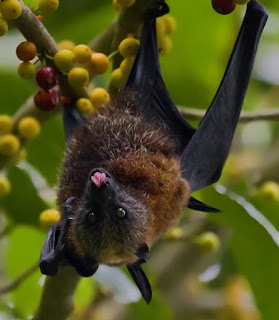
One of the things I love about American Samoa is the abundance of Fruit Bats here. Every evening you can see them flying around. Some of them are huge. But, they can also be seen in the daytime, which makes it a great time to try and find one hanging around to photography. I found this tree with Fruit on it with a bunch of bats lounging away. Unfortunately at the time I did not have a long enough lens with me. The next afternoon I took my 100-400 lens and hoped the bats would still be around. As luck would have it, it was rainy, but I decided to make the 40-minute drive anyway. When I got there, there were a few bats hanging around. I sat in my car and waited for the rain to stop, which it did for about 5-minutes. I quickly jumped out of my car and my lens kept fogging up (got to love the humidity here). Now wiping my lens with a lens cloth in this humidity is a nightmare. I found that a lens pen works. These things work great and have a brush on one end, and this type of eraser head on the other (do a google search or check out http://www.bhphoto.com/ where I order all my stuff from). It is the only thing that really helps me clean my lens and remove fog on the lens. Now, as a side note, I found that it helps to put your camera in a large ziplock bag with desiccant silica. This helps when you take your camera from a cool place (like my air condition house) to a warm place. I use the ones from Pelican. You just stick the thing in the oven when it needs it and it can be used again. They are great. Of course, you have to remember to use them (which I had forgotten in my rush). In the end, got a couple of photos before it started raining too hard. But I like this photo with it's tongue sticking out.






















